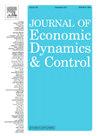在一个简单的多主体宏观经济模型中学习综合通货膨胀预测
IF 1.9
3区 经济学
Q2 ECONOMICS
引用次数: 0
摘要
本文实现了一个具有异质宏观预测者群体的模型。他们的目标是预测产出和通货膨胀,这两者都是标准的新凯恩斯宏观模型的输入。该模型首先通过在微观层面上将代理校准为专业预测者来实现。然后,模型运行试图复制预测和经济的动态、偏差和横截面异质性。这些都是在一个静态预测者的模型中完成的,在一个预测者以社会方式相互学习的模型中完成的。我们发现,假设接近随机游走行为的通胀过程预期可以自我实现,从而产生与美国宏观数据数量级相当的通胀波动性和持久性。然而,我们的预测群体往往缺乏调查数据预测的异质性。在某些情况下,货币政策可以用来将模型从不稳定/持久的均衡转向更稳定的、强烈的平均回归通胀率。本文章由计算机程序翻译,如有差异,请以英文原文为准。
Learning integrated inflation forecasts in a simple multi-agent macroeconomic model
This paper implements a model with a population of heterogeneous macro forecasters. Their objectives are to forecast output and inflation, both inputs in standard New Keynesian macro models. The model is implemented by first calibrating the agents to professional forecasters at the micro level. Model runs then try to replicate both the dynamics, bias and cross sectional heterogeneity of forecasts and the economy. These are done both in a model with static forecasters, and one where the forecasters are learning from each other in a social fashion. We find that expectations about the inflation process which conjecture near random walk behavior can be self-fulfilling, yielding inflation volatility and persistence on the order of magnitude of U.S. macro data. However, our forecasting populations often fall short of the heterogeneity of predictions from survey data. In some cases, monetary policy can be used to shift the model from its volatile/persistent equilibrium over to a more stable, strongly mean reverting inflation rate.
求助全文
通过发布文献求助,成功后即可免费获取论文全文。
去求助
来源期刊

Journal of Economic Dynamics & Control
ECONOMICS-
CiteScore
3.10
自引率
10.50%
发文量
199
期刊介绍:
The journal provides an outlet for publication of research concerning all theoretical and empirical aspects of economic dynamics and control as well as the development and use of computational methods in economics and finance. Contributions regarding computational methods may include, but are not restricted to, artificial intelligence, databases, decision support systems, genetic algorithms, modelling languages, neural networks, numerical algorithms for optimization, control and equilibria, parallel computing and qualitative reasoning.
 求助内容:
求助内容: 应助结果提醒方式:
应助结果提醒方式:


